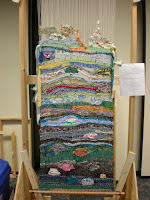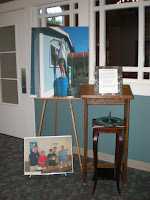
The Saga of the Woven Paraments Part 4:
Our goal became to create, through artful integration, a finished piece where dissimilar materials not only co-exist, but actually enhance each other. The blocks of solid provide a resting place for the eye; the prints add interest; the airy, open areas elevate the tenor. The dense supplies grounding for the sheer; the delicate softens the heavy. The light-colored fabric sets off the dark, so that each looks better than it did when standing alone. We began weaving from the bottom, working upward, and the design functions in the same way; the eye tends to look at the bottom of the piece first and is led upward. The lower area has more horizontal lines and is woven more tightly, giving a grounded effect. As the eye is drawn upward, some spaces open up, and some of the lines become more vertical. Also, the predominant colors become lighter as the design moves upward. By the time the viewer’s eye reaches the top, the materials have become slender and vertical, spiraling aloft. The suggestion is that of a tree, growing upward. The symbolism is that of ordinary time, when our growth should be spiritual, towards God.
Our congregation responded generously to our appeal for materials. We received fabrics and fibers with historical or sentimental value, items that have imbued our banners with meaning. We attempted to mingle all of these varied colors and fabrics, finding meaning and beauty together. We received such a wonderful outpouring - from sweaty t-shirts to wedding finery, from Boy Scout kerchiefs to Christmas Pageant costumes, from formal neckties to a dish towel of everyday family life, from the woolen plaid of a family tartan to the soft cotton of a baby’s onesie. Our hope is that these banners are a tangible depiction of the way our congregation is tightly woven together in community. Accordingly, we have entitled them “The Woven Community”. We decided that sounds more sophisticated than “Strata, Blobs, and Zig-Zags”!

The pulpit cloth was designed and woven by Molly.
The arrangement of lights and darks makes it appear as if a shaft of sunlight is coming in from above.

Close up view of the left banner.

Close up view of the right banner.















































